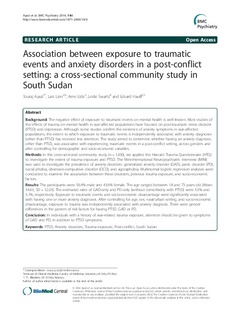Association between exposure to traumatic events and anxiety disorders in a post-conflict setting: a cross-sectional community study in South Sudan
Journal article, Peer reviewed
Permanent lenke
http://hdl.handle.net/11250/196944Utgivelsesdato
2014Metadata
Vis full innførselSamlinger
Originalversjon
Ayazi, T., Lien, L., Eide, A., Swartz, L. & Hauff, E. (2014). Association between exposure to traumatic events and anxiety disorders in a post-conflict setting: a cross-sectional community study in South Sudan. BMC Psychiatry, 14(6). 10.1186/1471-244X-14-6Sammendrag
Background: The negative effect of exposure to traumatic events on mental health is well known. Most studies of the effects of trauma on mental health in war-affected populations have focused on post-traumatic stress disorder (PTSD) and depression. Although some studies confirm the existence of anxiety symptoms in war-affected
populations, the extent to which exposure to traumatic events is independently associated with anxiety diagnoses (other than PTSD) has received less attention. The study aimed to determine whether having an anxiety diagnosis, other than PTSD, was associated with experiencing traumatic events in a post-conflict setting, across genders and after controlling for demographic and socio-economic variables.
Methods: In this cross-sectional community study (n = 1200), we applied the Harvard Trauma Questionnaire (HTQ) to investigate the extent of trauma exposure and PTSD. The Mini-International Neuropsychiatric Interview (MINI) was used to investigate the prevalence of anxiety disorders: generalized anxiety disorder (GAD), panic disorder (PD),
social phobia, obsessive-compulsive disorder (OCD), and agoraphobia. Multinomial logistic regression analyses were conducted to examine the association between these disorders, previous trauma exposure, and socio-economic factors.
Results: The participants were 56.4% male and 43.6% female. The age ranged between 18 and 73 years old (Mean 34.63, SD = 12.03). The estimated rates of GAD-only and PD-only (without comorbidity with PTSD) were 5.5% and 3.1%, respectively. Exposure to traumatic events and socio-economic disadvantage were significantly associated with having one or more anxiety diagnoses. After controlling for age, sex, rural/urban setting, and socio-economic disadvantage, exposure to trauma was independently associated with anxiety diagnosis. There were gender
differences in the pattern of risk factors for having PTSD, GAD or PD.
Conclusion: In individuals with a history of war-related trauma exposure, attention should be given to symptoms of GAD and PD, in addition to PTSD symptoms.
Beskrivelse
This is an Open Access article distributed under the terms of the Creative Commons Attribution License (http://creativecommons.org/licenses/by/2.0), which permits unrestricted use, distribution, and reproduction in any medium, provided the original work is properly cited. The Creative Commons Public Domain Dedication waiver (http://creativecommons.org/publicdomain/zero/1.0/) applies to the data made available in this article, unless otherwise stated.
